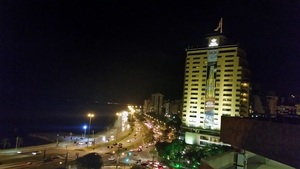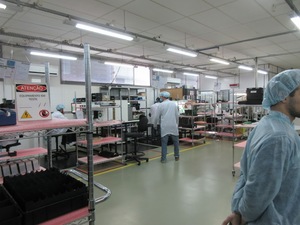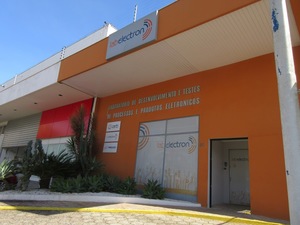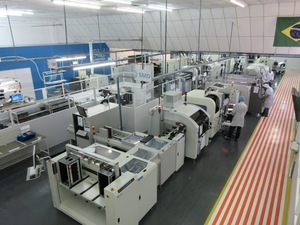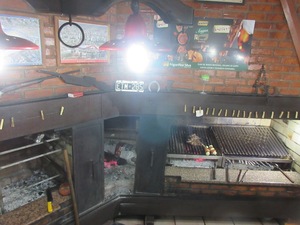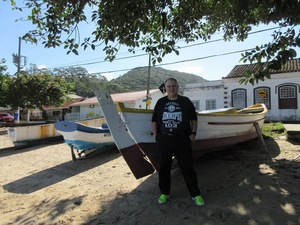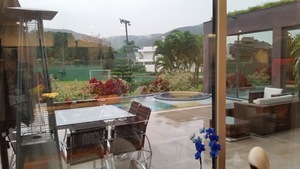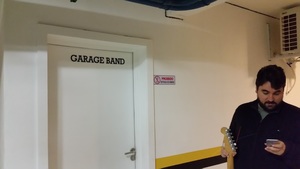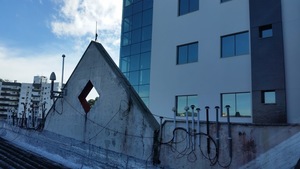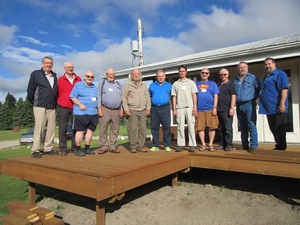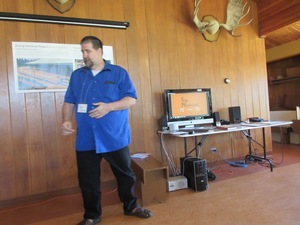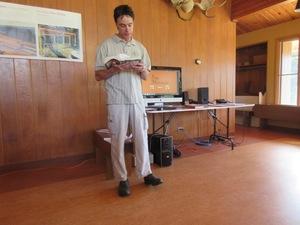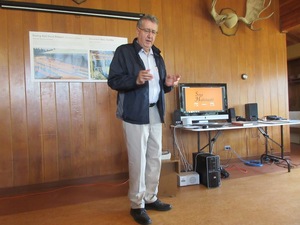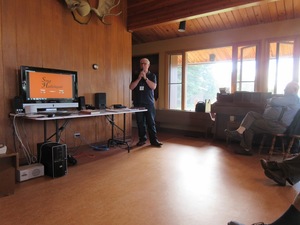
I bought a cool device called SPIDriver through CrowdSupply. Actually, I bought two – and got them each with a neat little SPI based 132 x 162 colour LCD display.
It’s a very neat device, appearing as a USB serial port to your system. On my LINUX system, it appears as /dev/ttyUSBn. There are several sample programs and libraries available to drive SPIDriver, including for the display.
The display operates with a Sitronix ST7735 controller – here are a couple of different version datasheets: ST7735 ST7735S_v1.1 .
Anyway, I hacked the included Python program st7735s.py to do my own bidding. irig_to_st7735.py takes STDIN text, uses the PIL library to rasterize it into graphics, and paints it into the little display.
Unfortunately, it takes about 1-1/2 seconds to get it transferred onto the display – it is a full graphics display, and it is a SPI interface, after all. I added an option to read_irig to put out 8 lines of text every 2 seconds, which I then piped into the Python program. It worked fine. Not terribly useful, but fine 🙂
#!/usr/bin/env python3
# coding=utf-8
#***************
# Import functions.
#---------------
import array
import getopt
import struct
import sys
import time
from PIL import Image, ImageDraw, ImageFont
from spidriver import SPIDriver
#***************
# Constants.
#---------------
Version = 0
Issue = 3
IssueDate = "2019-05-06"
DefaultDevice = "/dev/ttyUSB0"
LightBlue = (102, 255, 255)
PaleBlue = (102, 204, 255)
Red = (255, 0, 0)
Yellow = (255, 255, 0)
Lime = ( 0, 255, 0)
White = (255, 255, 255)
NOP = 0x00
SWRESET = 0x01
RDDID = 0x04
RDDST = 0x09
SLPIN = 0x10
SLPOUT = 0x11
PTLON = 0x12
NORON = 0x13
INVOFF = 0x20
INVON = 0x21
DISPOFF = 0x28
DISPON = 0x29
CASET = 0x2A
RASET = 0x2B
RAMWR = 0x2C
RAMRD = 0x2E
PTLAR = 0x30
COLMOD = 0x3A
MADCTL = 0x36
FRMCTR1 = 0xB1
FRMCTR2 = 0xB2
FRMCTR3 = 0xB3
INVCTR = 0xB4
DISSET5 = 0xB6
PWCTR1 = 0xC0
PWCTR2 = 0xC1
PWCTR3 = 0xC2
PWCTR4 = 0xC3
PWCTR5 = 0xC4
VMCTR1 = 0xC5
RDID1 = 0xDA
RDID2 = 0xDB
RDID3 = 0xDC
RDID4 = 0xDD
PWCTR6 = 0xFC
GMCTRP1 = 0xE0
GMCTRN1 = 0xE1
DELAY = 0x80
#***************
# Pure Python rgb to 565 encoder for portablity
#---------------
def as565(ProcessedImage):
#print ("ProcessedImage:", ProcessedImage)
OriginalRed, OriginalGreen, OriginalBlue = [list(c.getdata()) for c in ProcessedImage.convert("RGB").split()]
def MultiplyAndShift(ColourValue, ShiftBy):
return ColourValue * (2 ** ShiftBy - 1) // 255
d565 = [(MultiplyAndShift(BlueValue, 5) << 11) | (MultiplyAndShift(GreenValue, 6) << 5) | MultiplyAndShift(RedValue, 5) for (RedValue, GreenValue, BlueValue) in zip(OriginalRed, OriginalGreen, OriginalBlue)]
d565h = array.array('H', d565)
#print ("d565h:", d565h)
d565h.byteswap()
d565s = d565h.tostring()
#print ("d565s:", d565s);
return array.array('B', d565s)
def debug565(OriginalColour):
print ("OriginalColour:", OriginalColour)
OriginalRed, OriginalGreen, OriginalBlue = OriginalColour
def MultiplyAndShift(ColourValue, ShiftBy):
return ColourValue * (2 ** ShiftBy - 1) // 255
d565 = [(MultiplyAndShift(OriginalBlue, 5) << 11) | (MultiplyAndShift(OriginalGreen, 6) << 5) | MultiplyAndShift(OriginalRed, 5)]
d565h = array.array('H', d565)
print ("d565h:", d565h)
d565h.byteswap()
d565s = d565h.tostring()
print ("d565s:", d565s);
return array.array('B', d565s)
#***************
# Class for wrangling with the ST7735 160 x 128 dot display
#---------------
class ST7735:
def __init__(self, sd):
self.sd = sd
self.sd.unsel()
def write(self, a, c):
self.sd.seta(a)
self.sd.sel()
self.sd.write(c)
self.sd.unsel()
def writeCommand(self, cc):
self.write(0, struct.pack("B", cc))
def writeData(self, c):
self.write(1, c)
def writeData1(self, cc):
self.writeData(struct.pack("B", cc))
def cmd(self, cc, args=()):
self.writeCommand(cc)
n = len(args)
if n != 0:
self.writeData(struct.pack(str(n) + "B", *args))
def setAddrWindow(self, x0, y0, x1, y1):
self.writeCommand(CASET) # Column addr set
self.writeData(struct.pack(">HH", x0, x1))
self.writeCommand(RASET) # Row addr set
self.writeData(struct.pack(">HH", y0, y1))
self.writeCommand(RAMWR) # write to RAM
def rect(self, x, y, w, h, color):
self.setAddrWindow(x, y, x + w - 1, y + h - 1)
self.writeData(w * h * struct.pack(">H", color))
def start(self):
self.sd.setb(0)
time.sleep(.001)
self.sd.setb(1)
time.sleep(.001)
self.cmd(SWRESET) # Software reset, 0 args, w/delay
time.sleep(.180)
self.cmd(SLPOUT) # Out of sleep mode, 0 args, w/delay
time.sleep(.180)
commands = [
(FRMCTR1, ( # Frame rate ctrl - normal mode
0x01, 0x2C, 0x2D)), # Rate = fosc/(1x2+40) * (LINE+2C+2D)
(FRMCTR2, ( # Frame rate control - idle mode
0x01, 0x2C, 0x2D)), # Rate = fosc/(1x2+40) * (LINE+2C+2D)
(FRMCTR3, ( # Frame rate ctrl - partial mode
0x01, 0x2C, 0x2D, # Dot inversion mode
0x01, 0x2C, 0x2D)), # Line inversion mode
(PWCTR1, ( # Power control
0xA2,
0x02, # -4.6V
0x84)), # AUTO mode
(PWCTR2, ( # Power control
0xC5,)), # VGH25 = 2.4C VGSEL = -10 VGH = 3 * AVDD
(PWCTR3, ( # Power control
0x0A, # Opamp current small
0x00)), # Boost frequency
(PWCTR4, ( # Power control
0x8A, # BCLK/2, Opamp current small & Medium low
0x2A)),
(PWCTR5, ( # Power control
0x8A, 0xEE)),
(VMCTR1, ( # VCOM control
0x0E,)),
(MADCTL, ( # Memory access control (directions)
0xC8,)), # row addr/col addr, bottom to top refresh
(COLMOD, ( # set color mode
0x05,)), # 16-bit color
(GMCTRP1, ( # Gamma + polarity Correction Characterstics
0x02, 0x1c, 0x07, 0x12,
0x37, 0x32, 0x29, 0x2d,
0x29, 0x25, 0x2B, 0x39,
0x00, 0x01, 0x03, 0x10)),
(GMCTRN1, ( # Gamma - polarity Correction Characterstics
0x03, 0x1d, 0x07, 0x06,
0x2E, 0x2C, 0x29, 0x2D,
0x2E, 0x2E, 0x37, 0x3F,
0x00, 0x00, 0x02, 0x10)),
(NORON, ()), # Normal display on
(DISPON, ()), # Main screen turn on
]
for c, args in commands:
self.cmd(c, args)
def clear(self):
self.rect(0, 0, 128, 160, 0x0000)
def writestrings(self, ListOfLineStrings):
#print ("On entry into writestrings(), ListOfLineStrings: ", ListOfLineStrings)
#print ("Starting writestrings")
BaseWidth = 160
BaseHeight = 128
# make a blank image for the text, initialized to transparent text color
TextImage = Image.new('RGB', (BaseWidth, BaseHeight), ( 16, 16, 16))
TextSize = int(BaseHeight/ 8)
LineColours = (White, Lime, Lime, PaleBlue, LightBlue, LightBlue, Yellow, Red)
#print ("Length of list of LineColours: " + "{0:d}".format(len(LineColours)))
StartColumnOffset = 0
# get a font
#FontToWrite = ImageFont.truetype('Pillow/Tests/fonts/FreeMono.ttf', int(TextSize))
FontToWrite = ImageFont.truetype('Courier_New.ttf', int(TextSize))
# get a drawing context
DrawContext = ImageDraw.Draw(TextImage)
# draw text, full opacity
LineNumber = 1
for LineString in ListOfLineStrings:
#print ("LineString: " + LineString)
if (LineNumber > len(LineColours)):
print ("Past end of colour list, LineNumber = " + "{0:d}".format(LineNumber) + " and length of LineColours list = " + "{0:d}".format(len(LineColours)))
print ("Length of ListOfLineStrings = " + "{0:d}".format(len(ListOfLineStrings)))
print ("ListOfLineStrings: ", ListOfLineStrings )
print ()
LocalColour = White
else:
LocalColour = LineColours[LineNumber-1]
DrawContext.text((StartColumnOffset, (LineNumber-1)*TextSize), LineString, font=FontToWrite, fill=LocalColour)
LineNumber += 1
FinalImage = TextImage
# debug by saving images to disk
#print ("Output 01txt.jpg")
#SaveImage = TextImage.convert('RGB')
#SaveImage.save("01text.jpg")
#print ("Ouput 02base.jpg")
#SaveImage = BaseImage.convert('RGB')
#SaveImage.save("02base.jpg")
#print ("Ouput 03final.jpg")
#SaveImage = FinalImage.convert('RGB')
#SaveImage.save("03final.jpg")
#print ("FinalImage.size")
#print (FinalImage.size)
if FinalImage.size[0] > FinalImage.size[1]:
#print ("Rotating 90 degrees")
FinalImage = FinalImage.transpose(Image.ROTATE_90)
#w = 160 * FinalImage.size[0] // FinalImage.size[1]
#FinalImage = FinalImage.resize((w, 160), Image.ANTIALIAS)
#(w, h) = FinalImage.size
#if w > 128:
#FinalImage = FinalImage.crop((w // 2 - 64, 0, w // 2 + 64, 160))
#elif w < 128:
#c = Image.new("RGB", (128, 160))
#c.paste(FinalImage, (64 - w // 2, 0))
#FinalImage = c
st.setAddrWindow(0, 0, 127, 159)
#st.writeData(as565(FinalImage.convert("RGB")))
st.writeData(as565(FinalImage))
#***************
# Function to provide usage help.
#---------------
def usage():
print ("\nTake in read_irig LCD output and display to ST7735 display attached to SPIDriver, v"+"%1d" % (Version)+"."+"%1d" % (Issue)+" "+IssueDate+" dmw")
print ("\nTypical usage: "+sys.argv[0]+" [option]* ")
print ("\n Options: ")
print (" -o <device> Output device for SPIDriver (default " + DefaultDevice + ")")
print (" -v More verbose")
print ("\n RCS Info:")
print (" Header: /home/dmw/src/ntp/refclock_irig/RCS/irig_to_st7735.py,v 1.4 2019/05/17 03:37:27 dmw Exp")
print ("\n")
#***************
# Main function.
#---------------
if __name__ == '__main__':
#***************
# Get command line options. Error results in help text dump and exit.
#---------------
try:
opts, args = getopt.getopt(sys.argv[1:], "o:v")
except getopt.GetoptError as Error:
# print help information and exit:
print ("\n")
print (Error) # will print something like "option -a not recognized"
print ("\n------------------------------")
usage()
sys.exit(2)
#***************
# Set defaults.
#---------------
UseDevice = DefaultDevice
Verbose = False
#print ("Checking options now")
#***************
# Parse values from command line options. Error results in message and exit.
#---------------
for Option, Argument in opts:
#print ("Checking option: " + Option + ", with argument: " + Argument)
if Option in ("-o"): # Output file name.
UseDevice = Argument
#print ("\nUsing device: " + UseDevice)
elif Option in ("-v"): # Turn on verbosity.
Verbose = True
else:
print ("\nUnknown option \"" + Option + " " + Argument + "\", aborting...")
print ("\n------------------------------")
usage()
sys.exit(2)
if (Verbose):
print("\nLightBlue")
debug565(LightBlue)
print("\nPaleBlue")
debug565(PaleBlue)
print("\nRed")
debug565(Red)
print("\nYellow")
debug565(Yellow)
print("\nLime")
debug565(Lime)
print ("\nWhite")
debug565(White)
print ()
print ("\nUsing device: " + UseDevice)
print ()
#exit(0)
#***************
# Open ST7735 display through SPIDriver, initialize and clear.
#---------------
st = ST7735(SPIDriver(UseDevice))
st.start()
st.clear()
#***************
# Initial message.
#---------------
LineList = [
# 1111111
#1234567890123456
" IRIG Decoder",
"v"+"%1d" % (Version)+"."+"%1d" % (Issue)+" "+IssueDate,
" (c) 2019",
" Dean Weiten",
" Winnipeg, MB",
" (204)-888-1334",
" dmw@weiten.com"]
st.writestrings( LineList )
#***************
# Loop on input.
# Expecting up to 8 lines per frame,
# up to 16 characters per line.
# Colours are fixed sequence.
# An exception (often a ctrl-C break)
# results in clearing and exit message display.
#---------------
try:
LineIndex = 0
LineList = []
for line in sys.stdin:
FindFF = line.find('\f')
if (FindFF>=0):
if (Verbose):
print ("Got FF at " + "{0:d}".format(FindFF))
print( "The line up to the FF is \"" + line[:FindFF] + "\"." )
LineToAppend = line[:FindFF].rstrip("\r\n\f")
if (len(LineToAppend) > 0):
LineList.append(LineToAppend)
st.writestrings( LineList )
LineList = []
LineToAppend = line[FindFF+1:].rstrip("\r\n\f")
if (len(LineToAppend) > 0):
#print ("First line \"" + LineToAppend + "\" has length " + "{0:d}".format(len(LineToAppend)) + ", so will be appended, list is at present: \"", LineList, "\".")
LineList.append(LineToAppend)
else:
LineToAppend = line.rstrip("\r\n\f")
if (len(LineToAppend) > 0):
#print ("Line \"" + LineToAppend + "\" has length " + "{0:d}".format(len(LineToAppend)) + ", so will be appended.")
LineList.append(LineToAppend)
#print ("Length of LineList after append is " + "{0:d}".format(len(LineList)) + ".")
if (Verbose):
print( "The line list is:" )
print(LineList)
#st.writestrings(LoopNumber)
#LoopNumber += 1
finally:
st.clear()
#time.sleep(3)
LineList = [
# 1111111
#1234567890123456
" IRIG Decoder",
"v"+"%1d" % (Version)+"."+"%1d" % (Issue)+" "+IssueDate,
"",
" Exiting"]
st.writestrings( LineList )
time.sleep(4)
st.clear()



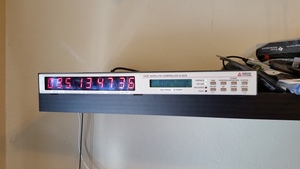
 WARNING! The following command will remove all data on the partition that you are encrypting. You WILL lose all your information! So make sure you backup your data to an external source such as NAS or hard disk before typing any one of the following command.
WARNING! The following command will remove all data on the partition that you are encrypting. You WILL lose all your information! So make sure you backup your data to an external source such as NAS or hard disk before typing any one of the following command.





